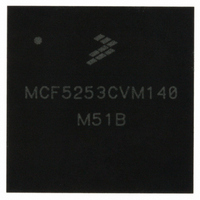MCF5253CVM140 Freescale Semiconductor, MCF5253CVM140 Datasheet - Page 374

MCF5253CVM140
Manufacturer Part Number
MCF5253CVM140
Description
IC MPU 32BIT 140MHZ 225-MAPBGA
Manufacturer
Freescale Semiconductor
Series
MCF525xr
Datasheets
1.MCF5253VM140J.pdf
(34 pages)
2.MCF5253VM140J.pdf
(8 pages)
3.MCF5253VM140J.pdf
(648 pages)
4.MCF5253VM140J.pdf
(2 pages)
Specifications of MCF5253CVM140
Core Processor
Coldfire V2
Core Size
32-Bit
Speed
140MHz
Connectivity
CAN, EBI/EMI, I²C, QSPI, UART/USART, USB OTG
Peripherals
DMA, WDT
Program Memory Type
ROMless
Ram Size
128K x 8
Voltage - Supply (vcc/vdd)
1.08 V ~ 1.32 V
Data Converters
A/D 6x12b
Oscillator Type
External
Operating Temperature
-40°C ~ 85°C
Package / Case
225-MAPBGA
Family Name
MCF5xxx
Device Core
ColdFire V2
Device Core Size
32b
Frequency (max)
140MHz
Instruction Set Architecture
RISC
Supply Voltage 1 (typ)
1.2/3.3V
Operating Supply Voltage (max)
1.32/3.6V
Operating Supply Voltage (min)
1.08/3V
Operating Temp Range
-40C to 85C
Operating Temperature Classification
Industrial
Mounting
Surface Mount
Pin Count
225
Package Type
MA-BGA
Lead Free Status / RoHS Status
Lead free / RoHS Compliant
Number Of I /o
-
Eeprom Size
-
Program Memory Size
-
Lead Free Status / Rohs Status
Compliant
Available stocks
Company
Part Number
Manufacturer
Quantity
Price
Company:
Part Number:
MCF5253CVM140
Manufacturer:
FREESCALE
Quantity:
300
Company:
Part Number:
MCF5253CVM140
Manufacturer:
Freescale Semiconductor
Quantity:
10 000
Part Number:
MCF5253CVM140
Manufacturer:
FREESCALE
Quantity:
20 000
Company:
Part Number:
MCF5253CVM140J
Manufacturer:
Freescale Semiconductor
Quantity:
10 000
- MCF5253VM140J PDF datasheet
- MCF5253VM140J PDF datasheet #2
- MCF5253VM140J PDF datasheet #3
- MCF5253VM140J PDF datasheet #4
- Current page: 374 of 648
- Download datasheet (8Mb)
Background Debug Mode (BDM) Interface
displayed. (debug data: DDATA). The processor status (PST) timing is synchronous with the processor
status clock (PSTCLK) and may not be related to the current bus transfer.
of these signals.
The PST outputs can be used with an external image of the program to completely track the dynamic
execution path of the machine when used with external development systems. The tracking of this dynamic
path is complicated by any change-of-flow operation. This is especially evident when the branch target
address is calculated based on the contents of a program-visible register (variant addressing.) For this
reason, the DDATA outputs can be configured to display the target address of these types of
change-of-flow instructions. Because the DDATA bus is only 4 bits wide, the address is displayed a nibble
at a time across multiple clock cycles.
The debug module includes two 32-bit storage elements for capturing the internal ColdFire bus
information. These two elements effectively form a FIFO buffer connecting the processor’s high-speed
local bus to the external development system through the DDATA signals. The FIFO buffer captures
branch target addresses along with certain operand data values for eventual display on the DDATA output
port, a nibble at a time, starting with the least-significant bit. The execution speed of the ColdFire
processor is affected only when both storage elements contain valid data waiting to be dumped onto the
DDATA port. In this case, the processor core is stalled until one FIFO entry is available. In all other cases,
data output on the DDATA port does not impact execution speed.
20.2.1
The PST signals are encoded to reflect the state of the Operand Execution Pipeline, and are generally not
related to the current external bus transfer.
20.2.1.1
Many instructions complete in a single processor cycle. If an instruction requires more clock cycles, the
subsequent clock cycles are indicated by driving the PST outputs with this encoding.
20.2.1.2
For most instructions, this encoding signals the first clock cycle of an instruction’s execution. Certain
change-of-flow opcodes, plus the PULSE and WDDATA instructions generate different encodings.
20.2.1.3
This encoding indicates the ColdFire processor has entered user mode. This encoding is signaled after the
instruction which caused the user mode entry has executed.
20.2.1.4
The ColdFire instruction set architecture includes a PULSE opcode. This opcode generates a unique PST
encoding, $4, when executed. This instruction can define logic analyzer triggers for debug and/or
performance analysis. Additionally, a WDDATA instruction is supported that allows the processor core to
write any operand (byte, word, longword) directly to the DDATA port, independent of any debug module
20-4
Processor Status Signal Encoding
Continue Execution (PST = $0)
Begin Execution of an Instruction (PST = $1)
Entry into User Mode (PST = $3)
Begin Execution of PULSE or WDDATA instructions (PST = $4)
MCF5253 Reference Manual, Rev. 1
Table 20-1
Freescale Semiconductor
shows the encoding
Related parts for MCF5253CVM140
Image
Part Number
Description
Manufacturer
Datasheet
Request
R
Part Number:
Description:
Mcf5253 Coldfire? Microprocessor Data Sheet
Manufacturer:
Freescale Semiconductor, Inc
Datasheet:
Part Number:
Description:
Manufacturer:
Freescale Semiconductor, Inc
Datasheet:
Part Number:
Description:
Manufacturer:
Freescale Semiconductor, Inc
Datasheet:
Part Number:
Description:
Manufacturer:
Freescale Semiconductor, Inc
Datasheet:
Part Number:
Description:
Manufacturer:
Freescale Semiconductor, Inc
Datasheet:
Part Number:
Description:
Manufacturer:
Freescale Semiconductor, Inc
Datasheet:
Part Number:
Description:
Manufacturer:
Freescale Semiconductor, Inc
Datasheet:
Part Number:
Description:
Manufacturer:
Freescale Semiconductor, Inc
Datasheet:
Part Number:
Description:
Manufacturer:
Freescale Semiconductor, Inc
Datasheet:
Part Number:
Description:
Manufacturer:
Freescale Semiconductor, Inc
Datasheet:
Part Number:
Description:
Manufacturer:
Freescale Semiconductor, Inc
Datasheet:
Part Number:
Description:
Manufacturer:
Freescale Semiconductor, Inc
Datasheet:
Part Number:
Description:
Manufacturer:
Freescale Semiconductor, Inc
Datasheet:
Part Number:
Description:
Manufacturer:
Freescale Semiconductor, Inc
Datasheet:
Part Number:
Description:
Manufacturer:
Freescale Semiconductor, Inc
Datasheet:











